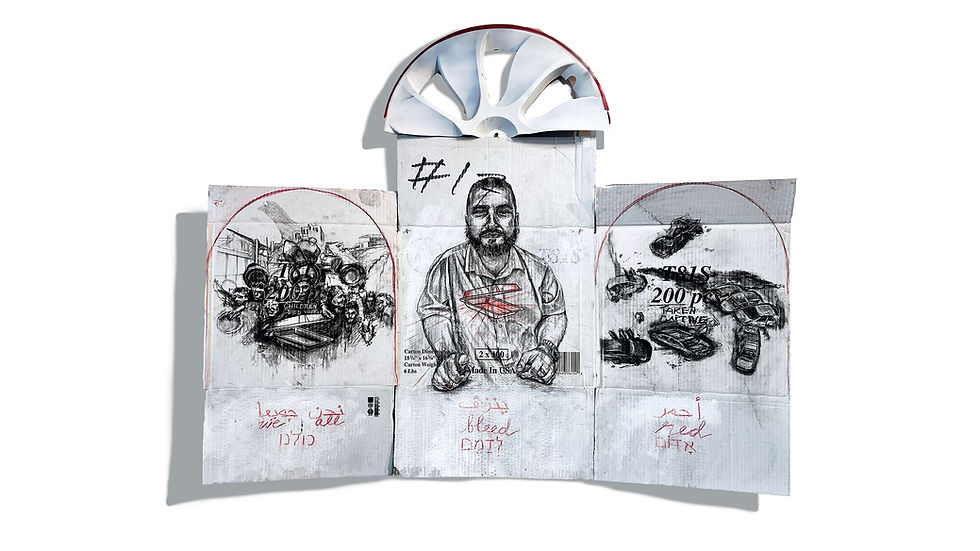Keeping the (Museum) Center Intact
- Joel Beers

- Aug 26, 2024
- 7 min read
Fullerton institution’s battle for survival relies on hard work, commitment and cold beer at a reasonable price.

Fullerton is a weird town. Not weird in the political parlance du jour, as something extreme or creepy or as a schoolyard label to ostracize those perceived as being different, but in the way a UC Riverside professor recently described it in an LA Times opinion piece: as a compliment, something “strikingly contrary to the ordinary, predictable, and easily comprehensible.”
For extraordinary, just look at the who’s who list of those born, raised, or who spent significant time there: everyone from presidents and Major League Baseball Hall of Famers, to musical icons, Hollywood big shots, and authors like Philip K. Dick and C.S. Forester, the guy who wrote the novel adapted into the screenplay for “The African Queen.”
Unpredictable? Orange County’s first public university founded in 1957 eventually becoming the largest in the 23-campus California State University System. Incomprehensible? A city that hasn’t had a venue dedicated to live music since Steamer’s Jazz Café closed nearly a decade ago featuring more musicians and venues in this year’s international Make Music Day than all other greater Los Angeles area cities combined. And for sheer weirdness, try this one: Fullerton is where both Hawaiian Punch and the first mass-produced electric guitar were born.
Weird is also the Fullerton Museum Center, both for its 35-year track record of presenting the most eclectic programming of any cultural institution in the county, and the fact that despite the city abruptly cutting off all funding four years ago, it’s still operational.
Credit for that goes to an overworked and underpaid skeleton staff, a nonprofit board whose members have been forced to take a much more hands-on approach to running it, a small army of volunteers and community members pitching in to keep it afloat, and an executive director whose creativity and resourcefulness has managed to keep the lights on while remaining true to the museum’s mission.
But while its funding situation may be more extreme than most, in this post-pandemic economic reality few cultural and artistic institutions aren’t working more with less or exploring new ways to attract patrons. But remember, Fullerton is kind of weird, so of course the museum’s narrative has a different twist. Because one of the main reasons it’s still running, even if that engine is currently “running on fumes,” according to its executive director, is something that the great cultural aficionado Homer Simpson would appreciate:
God Created Beer
“If you want to know what ‘s going on in the city, go to the beer garden,” says Davis Barber, who is in his second stint on the museum’s board of trustees.
The FMC’s beer garden is set up on the museum’s patio and is usually open during most museum events; but it also serves as the museum’s most liquid community outreach, as it is adjacent to the city-owned Downtown Fullerton Plaza. Anytime there’s an event in the plaza, like the Thursday Fullerton markets during the summer, or a city-wide event like the art walk on the first Friday of each month, the beer garden is open.
Before the pandemic, when the city subsidized the museum, the museum kicked back a percentage of the beer garden receipts; but since the museum reopened in July 2021, the beer garden has become a vital source of revenue, accounting for nearly a third of its funds, according to the museum’s executive director Elvia Susana Rubalcava.
Proceeds from the beer garden have been an integral part of keeping the Fullerton Museum Center open.
Photos courtesy of Fullerton Museum Center
That revenue stream ultimately prompted the Fullerton Museum Center Association, the nonprofit that in 1989 took over the downtown building that had formerly housed the Museum of North Orange County, to reopen. Like most businesses in California, the museum shut down in March 2020. Three months later, the city, citing a nearly $8 million projected deficit, voted 5-0 to temporarily cut its $300,000 funding for the museum (that temporary cut proved to be permanent). The museum’s part-time employees had been laid off in April, and its three full-time employees were supposed to be transferred to other city departments.
Without the city’s subsidy, the museum, which operates in a city-leased building owned by the North Orange County Community College District, announced it would shut down for the entirety of 2020. In August 2020, Rubalcava, who had been the museum’s operations manager, was laid off along with the executive director. The museum’s future was in limbo for a year. In June 2021, the city council approved a museum request for $150,000, allowing it to open three days a week. But when the museum’s board finally got the keys back, the nonprofit’s president Janet Buzan said, it found a building with no computers, shut-off phone lines, in drastic need of a deep clean, and no staff.
But the city was getting ready to reopen the Thursday market and, “of course, it wanted to open the beer garden right away,” said board president Janet Buzan. “But we didn’t know where we stood until we got the keys back. At that point in time, we had to figure out if we could reopen at all.”
Belief in Museum’s Mission
Fortunately, the board knew someone who knew better than anyone if that would be possible: Ruvalcaba, who had served as the museum’s operating manager.
“She had a functional knowledge of the museum but most importantly, she knew how the day-to-day operations were run, and she knew the beer garden, and since we needed to make some money, she was the clear choice,” Buzan said.
But for Ruvalcaba, whose layoff the preceding August had been her third from a city job, the decision to accept the position wasn’t easy. A playwright and theater director, she had decided to pursue her art after the 2020 layoff and had ventured into filmmaking. When the board offered her the position of executive director, she would have two weeks and no staff to reopen.
But it was her belief in the museum’s mission that clinched the deal.
“This isn’t just a museum of diverse cultural exhibits,” she said. “It’s also a central meeting place for the community. There is an educational component and we are a place to discuss ideas and different ways of (promoting) critical thinking. So I feel that it’s our place to be a leader in the community and that’s been my guiding post.”

The museum reopened in July 2021 with a traveling exhibit that had been postponed due to the pandemic, “Have Blues Will Travel,” which explored the experiences of Black musicians performing in the American South during Jim Crow.
Three years later, it remains open. It has stayed true to its eclectic mix, with exhibits ranging from the history of tequila and photographs of Manzanar by Ansel Adams; self-curated shows like “Fullerton Art Town,” which displayed local artists' expressions and definitions of living in Fullerton; and its permanent exhibition celebrating the life and legacy of native son Leo Fender. It has partnered with community members on events such as Pride Fest; worked with the city on salutes to longtime Fullerton resident Tommy Lasorda and another native Fullertonian Mike Ness; continued its children’s education programming and museum studies internship program with Fullerton College; and increased the opportunity for local musicians and poets to perform.
In October, it will produce an evening of plays by local playwrights, and next year’s plans include exhibits on the history of O.C. punk music and a touring exhibit commemorating Johnny Cash’s landmark performance at Folsom Prison.
For its community enrichment efforts, the museum received a 2023 commendation as one of California’s top nonprofit agencies. But every day has been a financial struggle. Other than the city money received in 2021, it has survived through grants, private donations, sponsorships, ticket sales, rentals to outside groups and the occasional loan from the Fullerton Museum Association’s endowment.
Even a most welcome windfall – a grant of $4.5 million state for capital improvements – comes with complications. Since the grant announcement in June 2023, donations and sponsorships have fallen off. But more than a year later, the museum is yet to see any of that money.
“It’s been a long, arduous process,” Buzan said of the grant, the first disbursement of which was expected in June but is slogging through the state bureaucracy. “It’s a long, snail mail process,” Rubalcava said. “First, it was June, then the end of July, and now it looks like maybe in September. We’ve had to tap into our endowment just to make ends meet. And because everyone thinks we’ve already received the funding, donations and sponsorships have both declined.”
So once again, the museum is appealing to those who nursed it back to life. “We were basically abandoned by the city, but the community response has been so heartening,” Buzan said. “But we’ve had to build ourselves back up, so the message is that the museum is alive and doing as well as it can. But we need to encourage people to keep coming out and supporting us.”
And the best way to do that at the moment? Its next exhibit opens Sept. 7, ”The Art of Everything: The Art and Science of June Wayne,” which explores the relationship between art and science through the use of prints and textiles.
And there is one final Fullerton Market Thursday, Aug. 29, and the beer garden next to it will be open. And all proceeds will go to the Fullerton Museum Center.
Works by June Wayne, from left: "Self-Portrait," "Genetics" and "The Messenger."
Images courtesy of Fullerton Museum Center
‘The Art of Everything: The Art and Science of June Wayne’
When: Sept. 7-Jan. 5
Hours: Noon-8:30 p.m. Thursdays, noon-4 p.m. Fridays and Saturdays
Where: Fullerton Museum Art Center, 301 N. Pomona Ave., Fullerton
Admission: $10
Contact: (714) 519-4461; fulllertonmuseum.com




























_gif.gif)



%20(1)_gif.gif)